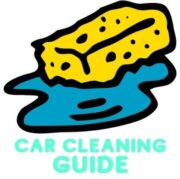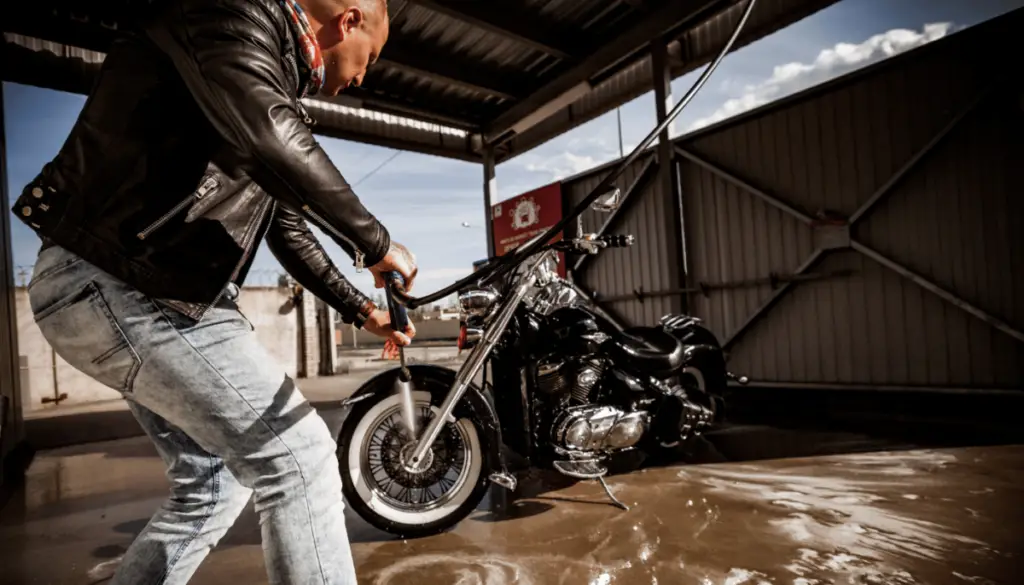- How to Clean Car Carpets Quick and Easy - July 10, 2024
- Can You Touch Up Clear Coat? Yes and No (Here’s Why) - November 25, 2023
- How To Wax A Car By Hand: A Comprehensive Guide - November 14, 2023
Last Updated on October 10, 2023 by Chase Manhattan
You’ve probably spent a lot of money on your bike, so you’ll want to keep it looking nice. A little extra practice in the motorcycle detailing department goes a long way toward protecting your investment and making sure that it lasts as long as possible. You can invest in some fancy products or take your bike to the shop—or you can do both if you like—but here are seven quick tips for keeping your motorcycle looking its best:

Quick Navigation
1. Get to know your bike
To get started, you need to know what your bike is made of. This will help determine what products work best for its specific materials and how much time you should spend on each step of the detailing process.
- For example, if you have a carbon fiber motorcycle frame or bodywork, then you don’t want to use any products that contain abrasives (such as polishes) because they could scratch up your precious finish!
- Another important factor is knowing which parts are made from plastic versus metal–and which ones are painted versus unpainted. This will ensure that you’re using only appropriate methods and materials when working on these areas:
2. Use the right tools
- Use the right tools. A good quality microfiber towel and sponge or wash mitt will help you get the job done faster, easier and with less effort.
- Use a good quality car shampoo or waterless wash for your first step in cleaning your bike, followed by a high-quality wax or paint sealant/primer if you want to protect its finish from UV damage (and make it shine). You can also polish out scratches with polishing compounds like Mothers’ Mag & Aluminum Polish ($10) before applying your wax or sealant so that they don’t show up as much later on when you’re done cleaning up around them.*
3. Wax on, wax off
Waxing is an important step in the detailing process. Wax will protect your paint, metal, rubber and plastic surfaces from UV damage and oxidation. It also keeps water spots at bay while adding another layer of protection to your bike’s finish.
Waxing a motorcycle requires a little elbow grease but isn’t difficult if you follow these steps:
- Remove loose dirt with a soft cloth or brush before applying a dedicated motorcycle wax. A clean surface will allow for better adhesion between layers of product (to prevent peeling).
- Make sure that the surface temperature is above 40 degrees Fahrenheit (4 degrees Celsius) before applying any coatings like polish or waxes so they don’t dry out prematurely on contact with cool air temperatures outside when working outdoors during winter months where temperatures may drop below freezing levels overnight causing condensation inside surfaces like helmets which could ruin their protective qualities such as UV protection properties found within some types
4. Clean off dirt, grime, bugs and tar spots
- Clean off dirt, grime, bugs and tar spots
To clean your motorcycle’s bodywork, use a good quality microfiber towel that won’t scratch it. Also make sure to use a good quality cleaner and waterless wash for the job–you’ll be amazed at how much dirt comes off with just one pass! If you’re cleaning up after riding in the rain or mud (or even dry dust), you might have some tar spots on the bike that need extra attention. For these situations I recommend using an acetone-based paint thinner – but be sure to follow a guide – so you don’t damage your paint removing stubborn stains on any chrome parts. An easier way to do this will be to soak your bike in foam, using a foam cannon before moving on to step 5 below:
5. Keep the chain lubed and clean
You should clean and lube your chain regularly. You can do this by spraying it with a degreasing solvent and scrubbing it with an old toothbrush, or you can use a chain cleaner that is designed to remove dirt and grime. If you have access to one of these cleaners, it will make the job much easier. After cleaning the chain, apply lubricant designed specifically for motorcycle chains (like Motul Chain Lube). This will help keep everything running smoothly in between oil changes, which should be done every 6 months or so depending on how often you ride your bike. If you’re in doubt, there are plenty of guides to show you how to clean a motorcycle chain.
6. Don’t forget about the tires (and other rubber)
- Don’t forget about the tires (and other rubber)
Tires are one of the most important parts of your motorcycle, so it’s important to take good care of them. The same goes for any rubberized surfaces on your bike. The first step in keeping your tires clean is using a tire cleaner to remove dirt and grime from them using a brush attachment or foam roller attachment (depending on what type you have). You should also use a damp sponge or microfiber cloth to wipe away any remaining grime after washing; this will prevent smudges from forming on the surface of your wheels where they won’t be able to come off with the next wash cycle!
Next up is protecting those precious wheels by applying some sort of dressing onto them. This could mean anything from waxes like Meguiar’s M105 ($36) which provides long-term protection against oxidation as well as corrosion resistance; sealants like Turtle Wax Onyx Paste ($12), which works great at repelling water; transparent coats such as Turtle Wax Pure White High Gloss Detailer ($20) which provides shine without attracting dust particles; UV protectors such as Griot’s Garage Microfiber Towel Drying Towel Set ($20); or even just regular old household items like dishwashing liquid mixed with warm water until it becomes slurry-like consistency before wiping down entire surface area lightly but thoroughly with soft cloths dipped into mixture then drying completely before applying another coat over top coat/sealant (which will protect against further damage).
Do not EVER use tire shine on motorcycle tires!
7. Protect it with a good quality coat of wax or paint sealant/primer
If you’re looking for a long-lasting protection, wax or paint sealant/primer is the way to go. These products will protect your bike from UV rays and moisture, which can cause rusting or discoloration. The downside? Waxes tend to wear off after a few months of riding in the sun, so they may need reapplication every few months (and even then they won’t last forever). On the other hand, paint sealants/primers can last up to five years before needing another coat applied–but keep in mind that this means you’ll have to wash off any dirt before applying it again!

Conclusion
We hope this article has helped you to understand the importance of motorcycle detailing. The fact is, your bike needs to be taken care of just like any other vehicle out there. And if you follow our tips for a clean and shiny ride, then chances are good that it will last longer too!
If you have any questions, don’t be afraid to ask! Otherwise, don’t hesitate to reach out to your local friendly professional.

